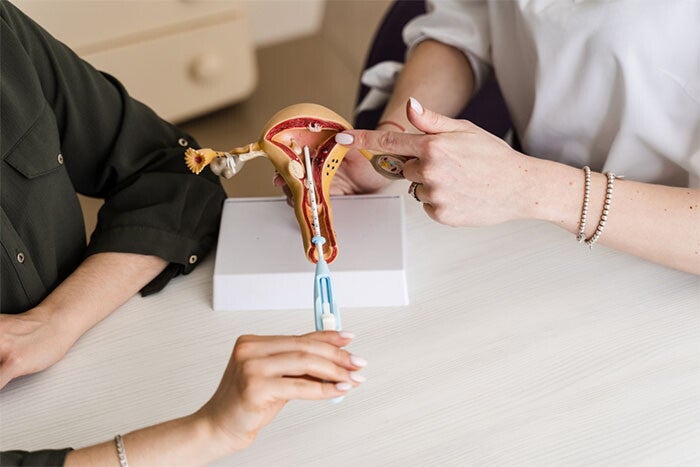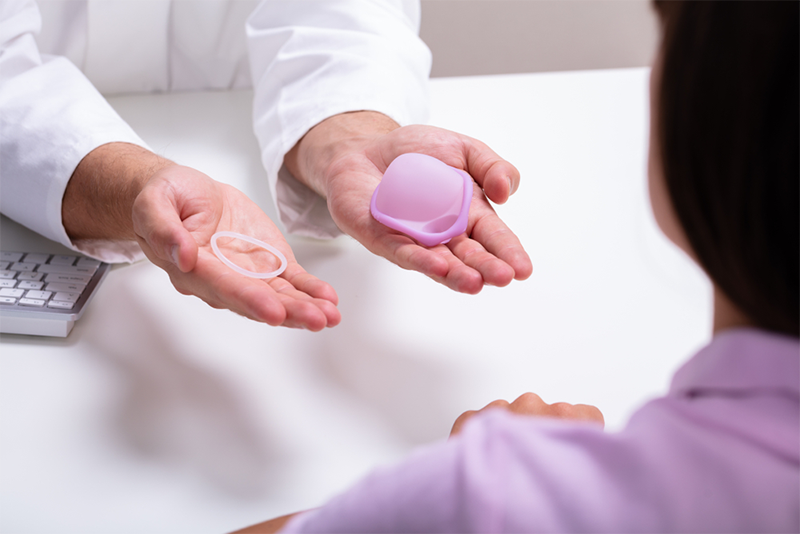
You've just welcomed your little one. Between sleepless nights and baby snuggles, you’re slowly settling into this new chapter—and maybe starting to think about birth control methods. After all, ovulation can return as early as four to six weeks after delivery, especially if you’re not exclusively breastfeeding.
Many new moms choose to space out their next pregnancy to look out for their physical and mental health. In fact, extensive research, including a recent systematic review published in PLOS One, supports the World Health Organization (WHO) recommendation to wait about 24 months after birth before your next pregnancy to help reduce health risks for you and your child.
Here are eight birth control methods you can consider after having a baby—each with its own pros, cons, and fit for your postpartum needs.
1. Intrauterine Devices (IUDs)

IUDs are one of many highly effective birth control methods. Talk to your ob-gyn about hormonal or copper IUDs.
An IUD is a small, T-shaped device that your doctor places in your uterus to prevent pregnancy. It's a great "set it and forget it" option. There are two kinds:
- Hormonal IUDs release a small amount of progestin to prevent pregnancy, and work for three to eight years.
- Copper IUDs create an environment where sperm can’t survive, are hormone-free, and effective for up to 10 to 12 years.
According to a study on IUD insertion timing, you can choose to have your IUD birth control inserted right after delivery (whether vaginal or C-section) or at your 6-week postpartum check-up. If you're breastfeeding, research confirm that both copper IUDs and hormonal IUDs are safe for you and your baby and shouldn't affect your milk supply.
Pros: IUD is highly effective (over 99%), long-lasting, reversible, and low-maintenance.
Cons: Insertion can cause temporary discomfort. Hormonal IUD side effects can include changes in bleeding patterns and sometimes mood changes. Copper IUDs might cause heavier periods or more cramping in the beginning.
2. Progestin-Only Pills (Minipills)
These minipills contain only progestin and work by thickening cervical mucus, which acts as a barrier to help block sperm from reaching an egg. Some pills also work to suppress ovulation. You need to take your pill at the same time every single day.
Pros: Progestin-only pills are 99% effective when taken consistently, and they're a good option for breastfeeding moms. They are also easily reversible if you decide you’re ready for another baby.
Cons: Irregular bleeding is a common side effect. Staying consistent with the minipill can also be a real struggle. It’s easy to forget to take it or get thrown off when traveling across time zones. So, it requires incredible self-discipline to use the pill effectively.
3. Contraceptive Implant
This tiny, matchstick-sized rod goes under the skin of your upper arm and slowly releases the hormone progestin over time. It stops your ovaries from releasing an egg and thickens cervical mucus to block sperm.
A contraceptive implant gives you continuous pregnancy protection for up to three years, and you can get it soon after your baby arrives. It's safe if you're breastfeeding and generally won't affect your milk production.
Pros: Contraceptive implants are 99% effective at preventing pregnancy. A 2021 systematic review of contraceptive implants found that popular implant brands effectively work at preventing pregnancy. Their effectiveness was so high (rated with a 'Pearl Index" of 0.0) that pregnancies were extremely rare.
Cons: Implant side effects can include changes in menstrual bleeding, headaches, or weight gain for some. Implants also require a minor procedure for insertion and removal.
4. Contraceptive Injection
This progestin-only injection is a type of depo contraceptive (slow-release injection method) given every three months to prevent ovulation.
Doctors will usually suggest getting your first shot about six weeks after your baby is born or once your milk supply is stable.
Pros: The contraceptive injection is 99.8% effective.
Cons: Depo injection side effects can include irregular bleeding, weight gain, and a potential delay in fertility after stopping. One popular brand in the US also has an FDA Black Box Warning for potential bone density loss, especially if used for more than two years. So, make sure to discuss these risks with your doctor.
5. Combined Hormonal Contraceptives
These include the birth control pill, birth control patch, and vaginal ring. Each birth control method contains a combination of estrogen and progestin to prevent ovulation. When you’re choosing which one to use, remember:
- The pill is taken orally every day.
- The patch is a thin sticker you wear on your skin. You change it once a week for three weeks, and then you have a patch-free week.
- The ring is a small, flexible ring inserted into your vagina for three weeks. Then, remove and leave out for a week.
Doctors usually recommend that you wait until six weeks after your baby is born before starting the pill, patch, or ring. These contraceptives contain estrogen, which can potentially reduce your milk flow in the early weeks after birth.
Pros: Combined hormonal contraceptives are 99% effective when used correctly and consistently. They can also help make periods more regular, lighter, and shorter, often with less cramping too.
Cons: Side effects can include nausea or breast tenderness due to estrogen. They’re not recommended if you’re at risk of blood clots.
6. Barrier Methods

Barrier methods are easily accessible and protect against STIs, just make sure to use them correctly every time!
Barrier methods, such as condoms and the diaphragm, physically block sperm from reaching an egg. These birth control methods are hormone-free and won't impact your breastmilk.
Condoms (male and female)
Male condoms are thin sheaths (made of latex or non-latex) rolled onto the penis. Female condoms (also called internal condoms) are soft pouches, usually made of nitrile, inserted into the vagina.
These condoms also help protect against sexually transmitted infections (STIs). You or your partner can start using them as soon as you feel ready after the baby.
Diaphragm
This shallow, dome-shaped cup is made of silicone and inserted into the vagina before sex, so it covers your cervix. You should always use it with spermicide (a cream or gel that blocks and kills sperm) to be effective.
For a proper fit, give your body time to heal and adjust after childbirth, usually around six weeks or more after childbirth. This allows your cervix to return to its usual size and position, ensuring the device will fit correctly. Plus, you'll probably need to be refitted if you've used one previously.
Cervical caps
Similar to the diaphragm but smaller, this thimble-shaped silicone cup fits snugly over your cervix and needs spermicide to work. Give your body time to recover postpartum since your cervix can change in size and shape. To ensure a cervical cap fits correctly, you’ll need a doctor to fit one in for you, usually at your six-week postpartum check-up or after. Keep in mind that cervical caps might not be less effective after vaginal birth.
7. Lactational Amenorrhea Method (LAM)
LAM is a natural, temporary way to prevent pregnancy after your baby arrives. It relies on exclusive breastfeeding, which can naturally delay your fertility from coming back. LAM only works under these three conditions:
- Your baby is younger than 6 months old.
- You exclusively breastfeed your baby on demand without long gaps between feeds.
- Your menstrual period has not returned since you delivered your baby.
Pros: Completely natural and fully supports the bonding and health benefits of exclusive breastfeeding.
Cons: Temporary—up to six months at most. If even one of the conditions above changes, LAM won’t be effective anymore.
8. Sterilization
Sterilization is a permanent birth control choice if you're sure you don't want to have more children.
- For women, the usual procedure is tubal ligation (often called BTL). This blocks or seals the fallopian tubes, which stop sperm from fertilizing an egg.
- For men, it's a vasectomy. This procedure blocks the tubes that carry sperm, so sperm doesn't come out during sex.
Doctors can often perform tubal ligation right after childbirth. Both are one-time medical procedures, and neither procedure affects breastfeeding.
Pros: Sterilization is 99% effective—you never have to worry about getting pregnant again.
Cons: Surgical procedures always carry some risk. Sterilization is also irreversible, so you and your partner should carefully discuss it before making a final decision.
How to Stay Safe When Choosing Birth Control Postpartum
Your health and safety are important, so make sure to consider these factors when exploring birth control methods:
- Timing: While some methods are suitable immediately postpartum, others (like those containing estrogen) have a recommended waiting period due to the increased risk of blood clots right after birth.
- Medical history: Conditions like high blood pressure, history of blood clots, certain cancers, or migraines with aura can make some options unsuitable. Always disclose your full medical history.
- Birth control side effects: All medications and devices can have potential side effects. Contact your healthcare provider if you experience worrying symptoms after starting a new method.
Knowing birth control methods allows you to confidently choose an option that aligns with your needs. but make sure you also talk to your ob-gyn, who can guide you in making a more informed decision tailored to your health, lifestyle, and family life.
Join the ParentTeam Moms and Dads Facebook group and connect with other parents so you can ask questions about postpartum birth control methods and family planning.
References
Frances E. Casey, “Intrauterine Device (IUDs; IUD),” MSD Manual Professional Edition, October 7, 2023, https://www.msdmanuals.com/professional/gynecology-and-obstetrics/family-planning/intrauterine-device-iuds-iud.
American College of Obstetricians and Gynecologists (ACOG). "Depot Medroxyprogesterone Acetate and Bone Effects." Committee Opinion No. 602, June 2014. Accessed May 19, 2025 https://www.acog.org/clinical/clinical-guidance/committee-opinion/articles/2014/06/depot-medroxyprogesterone-acetate-and-bone-effects.
Bolling, Kristina Rosa, Yesmean Wahdan, Neal Warnock, Jason Lott, Juliane Schoendorf, Federica Pisa, Evelyn Gomez-Espinosa, Kristin Kistler, and Brett Maiese. "Utilisation, Effectiveness, and Safety of Immediate Postpartum Intrauterine Device Insertion: A Systematic Literature Review." BMJ Sexual & Reproductive Health, published online December 8, 2022. https://doi.org/10.1136/bmjsrh-2022-201579.
Centers for Disease Control and Prevention. "Appendix D: Classifications for Combined Hormonal Contraceptives." In U.S. Medical Eligibility Criteria for Contraceptive Use, 2024. Atlanta, GA: Centers for Disease Control and Prevention, 2024. https://www.cdc.gov/contraception/hcp/usmec/combined-hormonal-contracep….
Centers for Disease Control and Prevention. "Appendix G: Lactational Amenorrhea Method." In U.S. Medical Eligibility Criteria for Contraceptive Use, 2024. Atlanta, GA: Centers for Disease Control and Prevention, 2024. https://www.cdc.gov/contraception/hcp/usmec/lactational-amenorrhea-method.html
Centers for Disease Control and Prevention. "Contraception and Birth Control Methods." Centers for Disease Control and Prevention. Last updated August 6, 2024. https://www.cdc.gov/contraception/about/index.html.
Department of Health, Philippines. The Philippine Family Planning Handbook, 2023 Edition. Manila: World Health Organization Philippines, 2024. Accessed May 15, 2025. https://cdn.who.int/media/docs/default-source/wpro---documents/countries/philippines/reports/phfphandbook-compressed.pdf?sfvrsn=1b2e1b63_1.
Lopez-Gonzalez, Diorella M., and Anil K. Kopparapu. "Postpartum Care of the New Mother." In StatPearls. Treasure Island, FL: StatPearls Publishing, 2025. Last updated December 11, 2022. https://www.ncbi.nlm.nih.gov/books/NBK565875/.
Planned Parenthood Federation of America. "How Effective Are IUDs?" Planned Parenthood. Accessed May 16, 2025. https://www.plannedparenthood.org/learn/birth-control/iud/how-effective-are-iuds.
World Health Organization. "Condoms." World Health Organization. February 14, 2025. https://www.who.int/news-room/fact-sheets/detail/condoms.
World Health Organization. "Contraception." World Health Organization. Accessed May 16, 2025. https://www.who.int/health-topics/contraception#tab=tab_3.
World Health Organization. "Lactational Amenorrhea Method." Sexual and Reproductive Health & Rights (SRHR). Accessed May 16, 2025. https://postpartumfp.srhr.org/methods/lactational-amenorrhea-method/.
World Health Organization. Medical Eligibility Criteria for Contraceptive Use, Fifth Edition 2015: Executive Summary. Geneva: World Health Organization, 2015. https://iris.who.int/bitstream/handle/10665/172915/WHO_RHR_15.07_eng.pdf?sequence=1.














